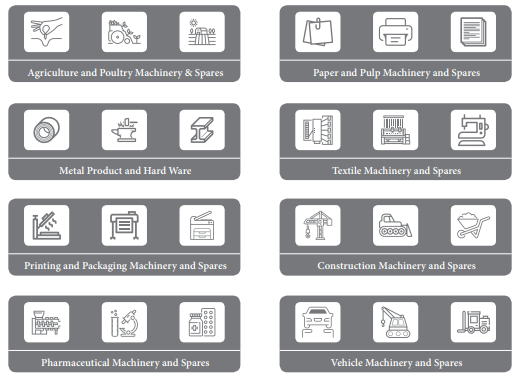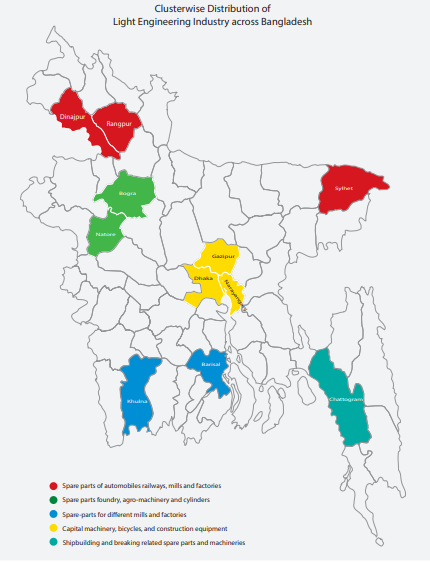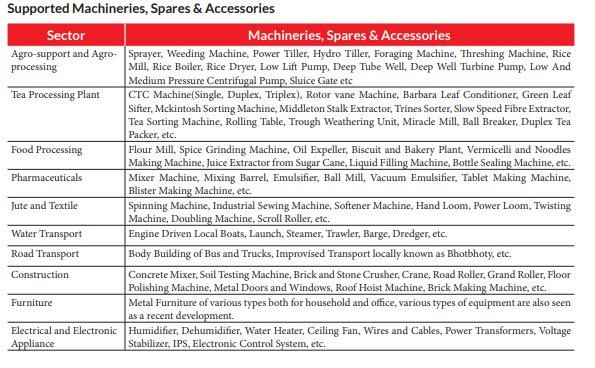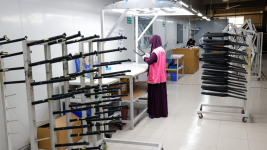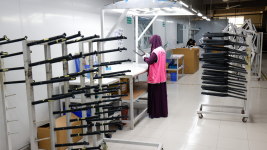Light Engineering - Sourcing Bangladesh
 www.sourcing-bangladesh.com
www.sourcing-bangladesh.com
Light Engineering - Sourcing Bangladesh
Industry Overview
Small and Medium Enterprises (SMEs) have been playing pivotal role in the economic development of Bangladesh. The contribution SMEs in GDP of Bangladesh is 20.25%. The sector comprises heterogeneous group ranging from trading to manufacturing depending on employment, turnover and capital employed. Light Engineering Sector (LES) is one of the SME sectors that has been playing a crucial role. Light Engineering Sector is largely comprised of small enterprises and some medium enterprises. According to the available information, the Light Engineering Sector (LES) in Bangladesh consists of over 40,000 firms and generates an annual revenue of about BDT 20,000 crores a year. Most of LES output plays a critical role in key national sectors such as agriculture, transportation, construction, RMG etc. According to rough estimations, Light Engineering Sector of Bangladesh created about 3,00,000 direct employment and at the same time around 30,00,000 indirect job opportunities in different supportive industries. It acts as feeder to key national industries. Export of Light Engineering products/ Equipment fetched over 600 million US$. It plays a vital role in the socio-economic development of the country. Light Engineering Industries (LEI) or more broadly Light Engineering Sector (LES) are the mother of all industries. Machinery and spare parts produced by the entrepreneurs of this sector are supplied to various mills and factories. Since, LES occupy a unique position in the economy of Bangladesh, it deserves due support from all concerned including Banks and NBFIs of the country.The Products are:
Spare parts of Paper & Cement Mills, Bicycle, Fancy light fitting, Construction equipment, Battery, Electrical wires and cables, Iron Chain, Cast iron articles, Carbon rod, Automobile spares, Electronics items, and Stainless Steel Wares.Product of LES in Bangladesh:
Light Engineering Sector in the range of SME posses a capital investment within the gamut from cottage to medium industries including small industries as has been defined in the industrial policy of the country. The product variety of this sector encompasses all kinds of ferrous and non ferrous metal products, foundry products, machinery, equipment and instruments (electrical and non-electrical), spare parts, electrical and electro-mechanical products, parts of machine and manufacturing processes that are made from ceramics, rubber, plastic, glass etc and the spares made of electronic components including circuits are considered as LES products. The sector predominantly consists of products from foundry and machine-shop. The electrical parts and gazettes also belong to this sector. The major services in the LES are repair, maintenance, erection, installation, fabrication, support services, consultancy etc.Product Lines of LES:
Product lines of LES are quite wide and diversified. It has been engaged in manufacturing machinery and spare parts for various engineering and non engineering sectors. Products of this sector are of proven quality and many of these items do confirm to export standards. They may be broadly classified as follows:Spare parts:
The subcontractors and other spare parts makers around the country have developed various types of spare parts locally. These spare parts commonly belong to rail engine, rail line, automobile, machine tools, jute and textile, tea processing, chemical industries (like fertilizer, cement etc), sugar and food industries, water transport, pharmaceutical industry, gas line fittings, bathroom fittings, electronic accessories, electrical accessories, agro-support and agro-processing, telecommunication, electrical pole fittings, water supply and irrigation, etc. Apart from these, there are LES throughout the those produce many other types of spare parts as per orders of their clients and market needs- Complete Machines:
The LES of the country also produce complete machines mostly belonging to the following sectors: - Agro-support and Argo-processing:
Sprayer, Weeding Machine, Power Tiller, Hydro Tiller, Foraging Machine, Threshing Machine, Rice Mill, Rice Boiler, Rice Dryer, Low Lift Pump, Deep Tube Well, Deep Well Turbine Pump, Low and Medium Pressure Centrifugal Pump, Sluice Gateetc. - Tea Processing:
CTC Machine (Single, Duplex, Triplex), Rotor vane Machine, Barbara Leaf Conditioner, Green Leaf Sifter, Mackintosh Sorting Machine, Middleton Stalk Extractor, Trines Sorter, Slow Speed Fibre Extractor, Tea Sorting Machine, Rolling Table, Trough Weathering Unit, Miracle Mill, Ball Breaker, Duplex Tea Packer, etc. - Food Processing:
Flour Mill, Spice Grinding Machine, Oil Expeller, Biscuit and Bakery Plant, Vermicelli and Noodles Making Machine, Juice Extractor from Sugar Cane, Liquid Filling Machine, Bottle Sealing Machine, etc. - Pharmaceuticals:
Mixer Machine, Mixing Barrel, Emulsifier, Ball Mill, Vacuum Emulsifier, Tablet Making Machine, Blister Making Machine, etc. - Jute and Textile:
Spinning Machine, Industrial Sewing Machine, Softener Machine, Hand Loom, Power Loom, Twisting Machine, Doubling Machine, Scroll Roller, etc. - Water Transport:
Engine Driven Local Boats, Launch, Steamer, Trawler, Barge, Dredger, etc. - Road Transport:
Body Building of Bus and Trucks, Improvised Transport locally known as Bhotbhoty, etc. - Construction:
Concrete Mixer, Soil Testing Machine, Brick and Stone Crusher, Crane, Road Roller, Grand Roller, Floor Polishing Machine, Metal Doors and Windows, Roof Hoist Machine, Brick Making Machine, etc. - Furniture:
Metal Furniture of various types both for household and office, various types of equipment are also seen as a recent development. - Electrical and Electronic Appliance:
Humidifier, Dehumidifier, Water Heater, Ceiling Fan, Wires and Cables, Power Transformers, Voltage Stabilizer, IPS, Electronic Control System, etc.
Prime Exportable Products of LEI :
Iron Steel , Copper Wire , Stainless Steel Ware , Engineering Equipment , Electrical Products and Bicycle are main exportable of Light Engineering Sector.
Main Export Market
The European Union (EU) countries are one of the biggest markets for bicycles, where consumers buy around 18 million units a year. This is the reason why Bangladeshi manufacturers are targeting the European markets for exports, especially to the UK, Germany, Italy and Netherlands. According to Eurostat, Bangladesh is the third-largest exporter of bicycles to the EU and the 8th largest exporter in the global market.The LE product iron and steel are exported in Saint Barthelme, Singapore, Indonesia, India, Myanmar, Thailand, Japan, Sri Lanka, Turkey, USA, Italy, Taiwan, UAE, Australia and bi-cycle are exported in Germany, UK, India, Belgium, Ireland, Spain, Denmark, Sweden, Italy, Australia, Finland, Russian Federation, Austria, Brazil, France.
Government policies for developing Light Engineering Sector:
- In the export policy 2018-21, Light Engineering products, including bicycle and auto parts, have been considered as one of the special development sectors. Several points are mentioned in the policy including:
| 01. | Supply of investment credit at reduced rate of interest on a high priority basis. |
| 02. | Moratorium on income tax; |
| 03. | Various cash assistances |
| 04. | Export credit on easy terms and reduced rate of interest; and |
| 05. | Subsidized rate for Air Transportation, Duty drawback and bond facilities |
- A plan has been undertaken to establish ‘Light Engineering Cluster Village’ near Dhaka in order to develop the Light Engineering industry.
- In the 8th- Five-Year Plan, emphasis has been given to attract FDI in the Light Engineering sector to increase investment, for greater and easier market access, and for easier transfer of technology. To facilitate FDI in the Light Engineering sector, the Govt. is planning to set up Special Economic Zones and hand over these SEZs to investors from Japan, China, India and other countries.
- In the Industrial Policy 2016, Light Engineering sector has been considered as one of the Highest Priority Sectors.
- 15% Cash incentives are being provided to ensure its competitiveness
- This sector has been included as special development sector in Export Policy 2018-21.
- A Light Engineering Cluster Village will be established near Dhaka for the development of Light Engineering industry; and
- A modern laboratory and common facilities center will be established for the development of light Engineering sector.









